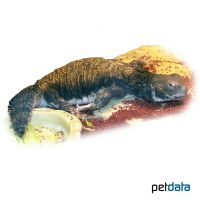Mali Spinytail Lizard (Uromastyx dispar maliensis)
| Mali Spinytail Lizard Uromastyx dispar maliensis | |
|---|---|
| Name | Mali Spinytail Lizard |
| Name Lat. | Uromastyx dispar maliensis |
| Family | Agamas |
| Family lat. | Agamidae |
| Order | Scaled Reptiles |
| Order lat. | Squamata |
| Origin | Western Africa |
| Habitat | Semi-desert |
| Diet | Green plants, fruits, insects |
| Humidity | 40-60 % |
| Behavior | ♂ territorial |
| Keeping | Individual, pair, harem |
| Care Level | Moderate |
| Reproduction | Oviparous |
| Housing | Dry terrarium |
| Life Span | 15-20 years |
| Protection | CITES Appendix II; EU Annex B |
| Metric Units | |
| Size | 40-50 cm |
| Temperature | 30-45 °C |
| Temperature Local | 50 °C |
| Housing Size | 150 x 120 x 90 cm |
| US Units | |
| Size | 16"-20" |
| Temperature | 86-113 °F |
| Temperature Local | 122 °F |
| Housing Size | 60" x 45" x 35" |
Distribution and habitat
The diurnal Mali thorn-tailed dragons are distributed from Algeria and Mauritania to Mali. There they live in the stony deserts and semi-deserts and retreat at night, but also during the day for thermoregulation in caves or in rock crevices.
Maintenance
The data are the minimum dimensions for the terrarium, according to the size and number of animals:
| 1-2 animals | 5KRL x 4KRL x 3KRL (L x W x H) |
Head-torso length (KRL) is measured on the largest animal. For each additional animal, increase the footprint by 15%. A terrarium of e.g. L 150 x W 120 x H 90 cm is recommended, which should be placed in a quiet and vibration-free place.
They need a well structured terrarium with stones and cemented rock structures with crevices (hiding places) and sunning places. As a substrate, locally warmed with a bottom heater, a 30 cm deep sand-loam mixture is suitable, in which they can make burrows. The bottom layer of soil should be kept slightly moist in places. A firmly anchored water container and an easy-to-clean feeding station, as well as potted dry grasses and succulents for decoration that cannot be reached by the animals, complete the setup. Once a day, preferably in the evening, the inside of the terrarium should be finely sprayed with water, a sprinkler system is better.
| Temp. day: 30-45 °C | Temp. night: 20-25 °C | Temp. local: up to 50 °C | Humidity: 40-60 |
The lighting duration must be 12-14 hrs. They need a high light intensity. Special lamps with high UV-A and UV-B content are ideal for the essential UV irradiation.
Diet
They need mainly plant food, such as various flowers (dandelion, evening primrose, clover, daisies), wild herbs (alfalfa, cress, mallow, parsley), vegetables (lettuce, peppers, zucchini, cabbage), Fruit (pears, melons, bananas, grapes) as well as swollen corn, lentils and seeds, alternatively commercial food for herbivorous reptiles, plus occasional live insects, such as grasshoppers, crickets etc., which must be offered regularly, especially to young animals. It is important to add minerals and vitamins. Their preferred food can vary greatly both seasonally and individually. Food must be offered fresh daily, drinking water must always be available. A varied diet promotes health and prevents deficiency symptoms.
Reproduction and breeding
The males usually have a broader head and a thicker tail root, where the hemipenis pockets are clearly visible. The female buries her eggs (over 20 of them) in the substrate. The incubation period is 80-100 days at a temperature of 31 °C. Small insects as well as finely cut fruit and meadow flowers are suitable as initial food for the young
Life expectancy can be 15-20 years.
Species protection
The animal population must be reported in writing to the competent authority immediately after the start of keeping. Subsequently, all arrivals and departures must be reported. Your pet store will be happy to provide you with further information.
Species protection: WA Appendix II; EU Appendix B The proof of purchase is the required proof of origin for the animal. Please keep it safe!
Important
Adult males behave very territorially among themselves. The muscular tail, covered with spiny scales, with which they close their burrows and crevices, serves them for defense and as a fat store
They need up to 50 °C warm sunny places (spotlights) and a strong temperature reduction at night (room temperature). For the necessary hibernation, the lighting duration is reduced by 2-3 hours for 1-2 months and the temperature is slowly lowered by 15 °C
The terrarium must have good ventilation without drafts and meet the species-specific needs. Measuring devices such as thermometers, hygrometers, etc. are necessary. The lighting has to correspond to the species-specific day-night rhythm and has to be placed in such a way that the animals cannot injure themselves. The terrarium should be locked in such a way that neither unauthorized persons can open it nor the animals can escape. Contamination must be removed regularly
Further literature can be found in your pet store.
References
Text: petdata; Image: petdata
Source: BMELV (1997): Tierschutzgutachten - Mindestanforderungen an die Haltung von Reptilien; ENGELMANN (2006): Zootierhaltung - Tiere in menschlicher Obhut: Reptilien und Amphibien, Harri Deutsch Verlag
- Gemäß § 21 Abs. 5 Tierschutzgesetz idgF
